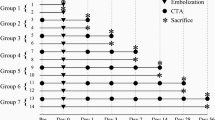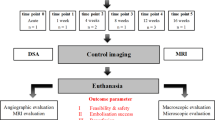Abstract
HepaSphere is a new spherical embolic material developed in a dry state that absorbs fluids and adapts to the vessel wall, leaving no space between the particle and the arterial wall. The aim of this study was to elucidate the final in vivo size, deformation, final location, and main properties of the particles when reconstituted with two different contrast media (Iodixanol and Ioxaglate) in an animal model. Two sizes of “dry-state” particles (50–100 and 150–200 μm) were reconstituted using both ionic and nonionic contrast media. The mixture was used to partly embolize both kidneys in an animal model (14 pigs). The animals were sacrificed 4 weeks after the procedure and the samples processed. The final size of the particles was 230.2 ± 62.5 μm for the 50- to 100-μm dry-state particles and 314.4 ± 71 μm for the 150- to 200-μm dry-state particles. When the contrast medium (ionic versus nonionic) used for the reconstitution was studied to compare (Student’s t-test) the final size of the particles, no differences were found (p > 0.05). The mean in vivo deformation for HepaSphere was 17.1% ± 12.3%. No differences (p > 0.05) were found in the deformation of the particle regarding the dry-state size or the contrast medium (Mann-Whitney test). We conclude that HepaSphere is stable, occludes perfectly, and morphologically adapts to the vessel lumen of the arteries embolized. There is no recanalization of the arteries 4 weeks after embolization. Its final in vivo size is predictable and the particle has the same properties in terms of size and deformation with the two different contrast media (Iodixanol and Ioxaglate).








Similar content being viewed by others
References
Pelage JP, Cazejust J, Pluot E, et al. (2005) Uterine fibroid vascularization and clinical relevance to uterine fibroid embolization. Radiographics 25:S99–S117
Pinto I, Chimeno P, Romo A, et al. (2003) Uterine fibroids: uterine artery embolization versus abdominal hysterectomy for treatment—a prospective, randomized, and controlled clinical trial. Radiology 226:425–431
Lee KH, Sung KB, Lee DY, Park SJ, Kim KW, Yu JS (2002) Transcatheter arterial chemoembolization for hepatocellular carcinoma: anatomic and hemodynamic considerations in the hepatic artery and portal vein. Radiographics 22:1077–1091
Winkelbauer FW, Niederle B, Pietschmann F, et al. (1995) Hepatic artery embolotherapy of hepatic metastases from carcinoid tumors: value of using a mixture of cyanoacrylate and ethiodized oil. AJR 165:323–327
Therasse E, Breittmayer F, Roche A, et al. (1993) Transcatheter chemoembolization of progressive carcinoid liver metastasis. Radiology 189:541–547
Laurent A, Wassef M, Saint Maurice JP, et al. (2006) Arterial distribution of calibrated tris-acryl gelatin and polyvinyl alcohol microspheres in a sheep kidney model. Invest Radiol 41:8–14
Pelage JP, Laurent A, Wassef M, et al. (2002) Uterine artery embolization in sheep: comparison of acute effects with polyvinyl alcohol particles and calibrated microspheres. Radiology 224:436–445
Beaujeux R, Laurent A, Wassef M (1996) Trisacryl gelatin microesphere for therapeutic embolization. II. Preliminary clinical evaluation in tumors and arteriovenous malformations. Am J Neuroradiol 17:541–548
White RI Jr, Strandberg JV, Gross GS, Barth KH (1977) Therapeutic embolization with long-term occluding agents and their effects on embolized tissues. Radiology 125:677–687
Siskin GP, Dowling K, Virmani R, Jones R, Todd D (2003) Pathologic evaluation of a spherical polyvinyl alcohol embolic agent in a porcine renal model. J Vasc Interv Radiol 14:89–98
Kwak BK, Shim HJ, Han S (2005) Chitin-based embolic materials in the renal artery of rabbits: pathologic evaluation of an absorbable particulate agent. Radiology 236:151–158
Rand T, Loewe C, Schoder M, et al. (2005) Arterial embolization of unresectable hepatocellular carcinoma with use of microspheres, lipiodol, and cyanoacrylate. CardioVasc Interv Radiol 28:313–318
Khankan AA, Osuga K, Hori S, Morii E, Murakami T, Nakamura H (2004) Embolic effects of superabsorbent polymer microspheres in rabbit renal model: comparison with tris-acryl gelatin microspheres and polyvinyl alcohol. Radiat Med 22:384–390
Hori S, Okada A, Sakamoto K (1996) A new embolic material: superabsorbent polymer microsphere and its embolic effects. Jpn J Interv Radiol 11:375–381, (in Japanese)
Osuga K, Khankan AA, Hori S, et al. (2002) Transarterial embolization for large hepatocellular carcinoma with use of superabsorbent polymer microspheres: initial experience. J Vasc Interv Radiol 13:929–934
Osuga K, Hori S, Kitayoshi H, et al. (2002) Embolization of high flow arteriovenous malformations: experience with use of superabsorbent polymer microspheres. J Vasc Interv Radiol 13:1125–1133
Stampfl S, Stampfl C, Rehnitz C, Schnabel Ph, Satzl S, Cristoph P, Henn C, Thomas F, Kauffmann GW, Richter GM (2007) Experimental evaluztion of early and long-term effects of microparticle embolization in two different mini-pigs models. Part I: Kidney. CardioVasc Interv Radiol 30:257–267
Gobin YP, Viñuela F, Vinters HV, Ji C, Chow K (2000) Embolization with radiopaque microbeads of polyacrylonitrile hydrogel: evaluation in swine. Radiology 214:113–119
Choe DH, Han MH, Kan GH, Yeon KM, Han MC (1997) An experimental study of embolic effect according to infusion rate and concentration suspension in transarterial particulate embolization. Invest Radiol 32:260–267
Cromwell LD, Freeny PC, Kerber CW, Kunz LL (1986) Histologic analysis of tissue response to bucrylate-pantopaque mixture. AJR 147:627–631
Castaneda-Zuniga WR, Sanchez R, Amplazt K (1978) Experimental observations on short and long term effects of arterial occlusion with Ivalon. Radiology 126:783–785
Bates WD, Davies DR, Welsh K, Gray DWR, Fuggle SV, Morris PJ (1999) An evaluation of the Banff classification of early renal allograft biopsies and correlation with outcome. Nephrol Dial Transplant 14:2364–2369
Laurent A, Wassef M, Chapot R, Houdart E, Merland JJ (2004) Location of vessel occlusion of calibrated tris-acryl gelatin microspheres for tumor and arteriovenous malformation embolization. J Vasc Interv Radiol 15:491–496
Acknowledgment
This study was supported by a grant from the Sociedad Española de Radiología Médica (SERAM).
Author information
Authors and Affiliations
Corresponding author
Rights and permissions
About this article
Cite this article
de Luis, E., Bilbao, J.I., de Ciércoles, J.A.G.J. et al. In Vivo Evaluation of a New Embolic Spherical Particle (HepaSphere) in a Kidney Animal Model. Cardiovasc Intervent Radiol 31, 367–376 (2008). https://doi.org/10.1007/s00270-007-9240-1
Received:
Revised:
Accepted:
Published:
Issue Date:
DOI: https://doi.org/10.1007/s00270-007-9240-1




